Buying Guide for 4X4 Awnings

Rain, hail or shine, you can’t beat vehicle-mounted awnings for the extra protection they provide at camp.
THE off-roader’s awning is a popular accessory for the four-wheeling community, and for good reason.
Not only do they provide valuable shelter from the UK’s unforgiving elements – heavy rain, strong wind and relentless sun (sometimes!) – by adding walls and/or annexes, they create additional enclosed areas for punters to store equipment or to spend their time cooking and relaxing without being punished by flies, bugs and the elements. Plus, they can be erected in the same amount of time it takes to pop open the fridge and crack the cap off your first cold beer.
Not only does an awning provide timely shelter for a roadside cuppa or a quick snooze at camp, they can also prove invaluable if a vehicle breakdown occurs.
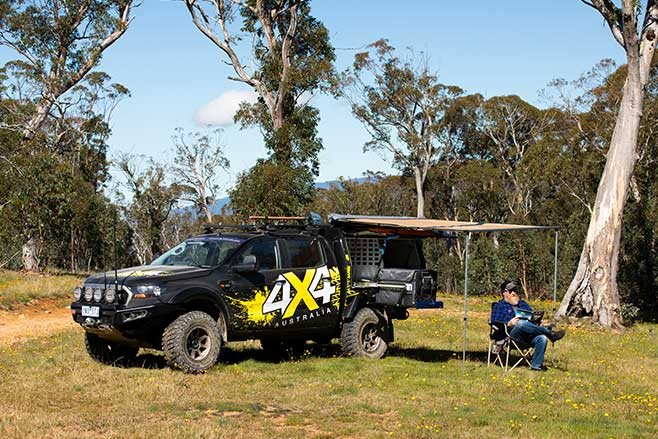
“There’s a reason why travellers are advised to stay with their vehicle when they break down in the outback, as exposure can be deadly,” said TJM’s James Jackson. “Anyone who has travelled in places like the Strzelecki or Simpson deserts knows that shade is hard to come by in these places, but if you have an awning you can create your own little oasis to have a cup of tea, make lunch or, in a worst-case scenario, wait for a good Samaritan in the case of a breakdown.”
While the idea of an awning may seem simple enough, it’s not an accessory you’ll want to skimp on when it’s time to swipe the credit card. There are many factors at play to ensure you get one that’ll stand up and protect when it’s needed most.
To dive deeper into the world of awnings, Which4X4 spoke to a handful of industry experts from ARB, Alu-Cab/Ironman 4x4, TJM, and Darche.
CORE COMPONENTS
WHEN trawling aftermarket catalogues in pursuit of the perfect awning setup for you and your family, you’ll notice various sizes, configurations and designs – some with two poles, some with four; some with guy ropes, some without.
However, despite the differences in appearances, a quality-made awning will share the same core components. To ensure the awning will remain standing during high wind and heavy rain – and provide adequate UV protection and prevent water ingress – it’s important to ensure it has a selection of non-negotiable build features.
“Build construction is key,” advised TJM’s James Jackson. “An awning that is made well will set-up and pack away smoothly on the fifth or 500th time.
“Small details like the right-sized bag or case will make unzipping or zipping up simple; well-manufactured telescopic legs won’t get stuck when extending or collapsing; and overall build quality will mean the awning will stand strong in rough weather conditions, which is exactly when you want it to perform.”
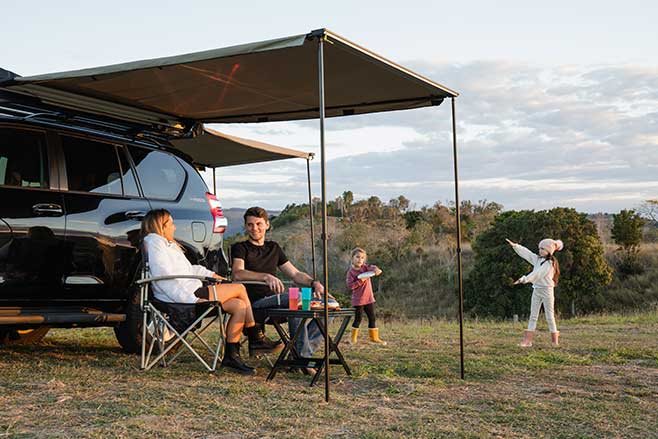
It’s widely agreed that the best quality awnings are typically constructed using a polyester/cotton ripstop canvas, which is used for its high UPF50+ UV rating (the canvas in combination with the coating on the canvas provides the UPF50+ rating), overall durability, and its ability to prevent water ingress and withstand extreme conditions for prolonged periods.
“The thick ripstop canvas blocks the rays, and the materials are treated with PU (polyurethane) coating to stop (the rays) coming through,” advised ARB’s Shannon Alderwick. “Canvas is also a natural material for repellence and UV exposure.”
For example, TJM awnings feature a 280gsm (grams per square metre) poly/cotton ripstop canvas, with 75mm side flaps and a 1000mm water column to drain water. Plus, there’s added sealing on all stitching to ensure there are no leaks.

Darche also uses a poly/cotton grid ripstop canvas, with a 320gsm count – “Darche awnings feature a PU coating that is highly UV-resistant and flexes when folded,” explained Darche’s Noel Anthony. “Cheaper acrylic coatings flake and chip off the surface of material, as well as break down much faster when exposed to UV.”
ARB awnings feature a 300gsm poly/cotton ripstop canvas, with inbuilt lighting and a 1000mm water column to repel water. The canvas is fully treated to withstand mould and mildew; plus, there’s added sealing and abrasion pads on all wear points.
The Alu-Cab 270 features a 315gsm ripstop polyester base cloth that is water head-rated to 600mm. “It is treated with a fungal-resistant chemical to prevent mould and mildew from developing,” added Alu-Cab’s Hannah van der Sluys. “Plus, the base cloth is impregnated with a high performance acrylic resin and a heat-reflective coating, which allows the awning to cast a lower shade temperature.”
You’ll also be able to spot a sub-par awning courtesy of the quality of its stitching – if it’s badly stitched, steer clear.
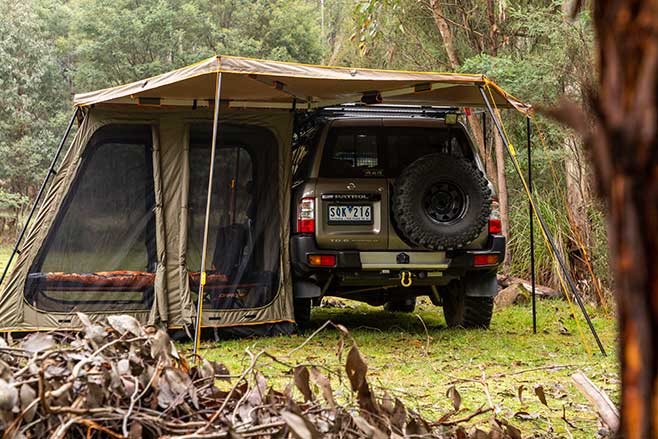
In addition to the canvas material, it’s important to ensure the awning poles (and the pole joints and rivets) are built to a high standard, using quality material. Ideally, ensure the arms and joints are flexible, as they’re more prone to snap if they’re too rigid.
“Ironman 4x4 opt to use highly flexible plastic pole joiners which protect the awning in case of wind damage or squashing,” explained Hannah van der Sluys. “This is opposed to using aluminium pole joiners which can crack or bend out of shape.”
On this point, Shannon from ARB added that quality nylon joints are less likely to snap in high winds.
Other features to look for include extrusions that extend the full length; abrasion strips and pads; and additional accessories such as pegs and guy ropes. Most modern awnings will also feature embedded LED lighting strips, to ensure your camp setup kicks on long after the sun sets.
In addition to rigid/fixed joints and thin canvas, also avoid lightweight aluminium and extrusions, as this heightens the chance of failure down the track, and also check that the awning doesn’t hinder a rooftop tent from opening.
WIND-RESISTANT
AN awning that will buckle at the first hint of a breeze is entirely useless for 4x4 travel. Experienced tourers will tell you how volatile the weather can be when exploring our vast continent, so it’s essential to have an awning that’ll survive strong winds, heavy rain and relentless sunshine.
“If the vehicle-mounting system is strong, the legs are made from strong materials and the design allows for flex in the joints – and you set up your awning correctly in terms of using guy ropes and setting your pole height – a high-quality awning can survive incredibly rough weather,” explained TJM’s James Jackson.
Ironman 4x4’s Hannah van der Sluys added: “Alu-Cabs’ 270-degree awning centre arm features an integrated drop-down pole that can be used to brace the awning for extra support. Additionally, each of the four awning arms boast a tie-down strap ideal for use in inclement weather conditions.”
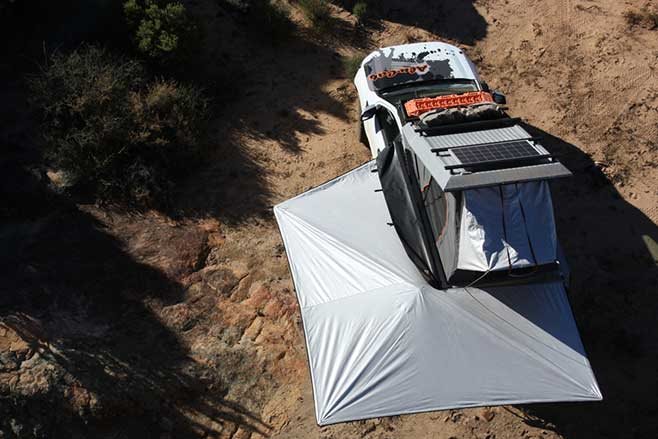
An optional Alu-Cab Storm Kit is available, which offers additional anchorage and prevents rain water from pooling on the awnings canvas in extreme weather conditions.
Shannon Alderwick added that good guy ropes and pegs are invaluable assets to ensure your awning remains sturdy during windy conditions. “Use good guy ropes and pegs,” she said. “Don’t use steel pegs at the beach, purchase good quality sand pegs. And, if the wind is too strong, pull the awning down.”
Remember, it never hurts to smack additional pegs into terrafirma for further support – plus, the use of guy ropes will keep your awning firmly planted in the soil. The weather can change quickly, so even if there’s not a breath of wind, it can change on a dime.
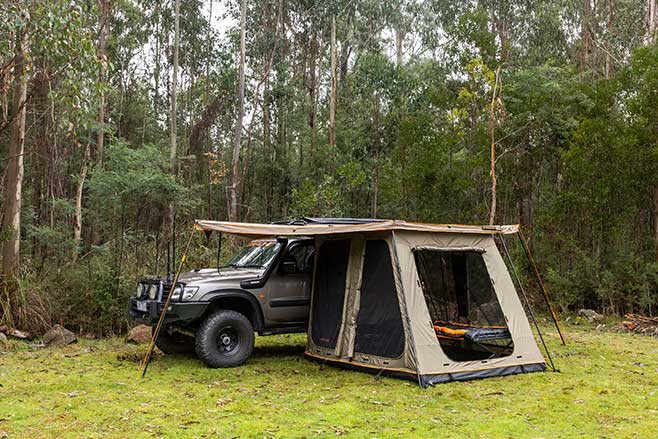
As Noel Anthony from Darche explained: “Always use guy ropes and poles, even in calm weather, and be prepared to pack away the awning if winds get too strong.”
Noel added that another handy tip to ensure the awning will survive strong winds is to park the vehicle so that the awning faces away from the prevailing wind rather than pointing into it.
SET UP AND TAKE DOWN
ONCE an awning is installed, typically to your roof-rack or roof-bar systems via supplied mounting brackets, to set up it’s simply a matter of rolling it out and unfolding the legs.
“Anyone who has done it once can set up a TJM awning in less than 30 seconds,” James Jackson advised.
It’s no different using Alu-Cab’s 270° Shadow Awning, which has been designed to set up in one motion, with no additional poles required to pitch – “The 270° Awning sets up in less than 30 seconds; simply unzip the bag, swing the awning through to a full 270 degrees and clip in place,” Hannah van der Sluys explained.
Noel Anthony advised us that all Darche awnings come with instructions and can be set up by one person, and it should take no more than three minutes tops.
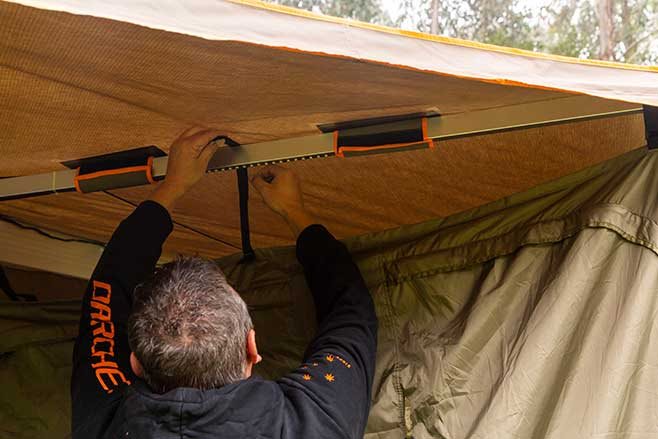
Setting up an ARB awning takes no longer, with Shannon Alderwick telling us that with a bit of practice, you will be set up in no time.
A great tip when it rains is to adjust one telescopic leg pole to be shorter than the other, so that the awning sits on an angle and the rain can more easily drain off. DARCHE awnings also feature gutter tubs, which is a useful addition to help with rain run-off.
When you’re ready to hit the road again, ensure the awning is rolled up tight and hugs the vehicle as tight as possible to ensure it doesn’t snag on branches when you’re out exploring.
TYPES OF AWNINGS
SIDE awnings are the most commonly used, mainly for their practicality and ease of operation. They’ll typically be mounted to the side section of a roof rack, providing ample sheltered space in the process.
Another option is a rear awning, which (quite obviously) is mounted to the rear of the vehicle’s roof rack/roof bars. Clearly, less space is afforded by mounting your awning to the rear. However, it’s quite common to see people with both side and rear awnings for an abundance of undercover capacity.
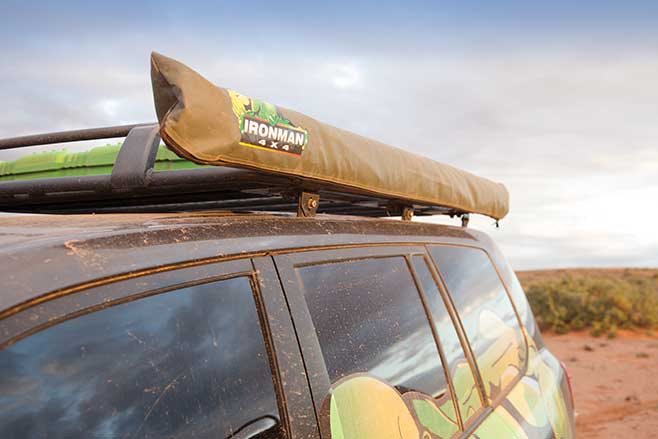
Instead of purchasing separate side and rear awnings, you could opt for a style called ‘270-degree awnings’, like the Alu-Cab Shadow Awning. These differ from your ‘regular’ awnings by spanning out a full 270 degrees and providing plenty more sheltered space at both the side and rear of the vehicle. They typically unfold in much the same way as regular awnings, but they feature a hinge that allows the awning to unfold further. 180-degree awnings are another option that might better suit your set-up.
You can also opt for a retractable awning that utilises something like a spring-tensioned roller, which takes the manual work out of setting up and taking down.
AFTER-SALES SUPPORT
AS with any aftermarket purchase, it’s vital to ensure you purchase from a supplier that provides adequate after-sales support. Most of the reputable brands will offer substantial warranties for their products, and all of them will provide valuable assistance during your ownership of the awning.
View our range of Awnings here.
Article Credit - whichcar.com.au/4x4australia

